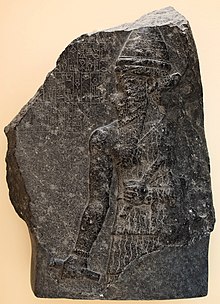Our website is made possible by displaying online advertisements to our visitors.
Please consider supporting us by disabling your ad blocker.
Naram-Sin of Akkad
| Naram-Sin 𒀭𒈾𒊏𒄠𒀭𒂗𒍪 | |
|---|---|
 Portrait of Naram-Sin | |
| King of the Akkadian Empire | |
| Reign | c. 2254 – 2218 BC |
| Predecessor | Manishtushu |
| Successor | Shar-kali-sharri |
| Issue | Shar-Kali-Sharri |
| Dynasty | Dynasty of Akkad |
| Father | Manishtushu |
Naram-Sin, also transcribed Narām-Sîn or Naram-Suen (Akkadian: 𒀭𒈾𒊏𒄠𒀭𒂗𒍪: DNa-ra-am DSîn, meaning "Beloved of the Moon God Sîn", the "𒀭" a determinative marking the name of a god), was a ruler of the Akkadian Empire, who reigned c. 2254–2218 BC (middle chronology), and was the third successor and grandson of King Sargon of Akkad. Under Naram-Sin the empire reached its maximum extent. He was the first Mesopotamian king known to have claimed divinity for himself, taking the title "God of Akkad", and the first to claim the title "King of the Four Quarters". His military strength was strong as he crushed revolts and expanded the empire to places like Turkey and Iran. He became the patron city god of Akkade as Enlil was in Nippur.[1] His enduring fame resulted in later rulers, Naram-Sin of Eshnunna and Naram-Sin of Assyria as well as Naram-Sin of Uruk, assuming the name.[2][3]
- ^ Steinkeller, Piotr, "The Divine Rulers of Akkade and Ur: Toward a Definition of the Deification of Kings in Babylonia", History, Texts and Art in Early Babylonia: Three Essays, Berlin, Boston: De Gruyter, pp. 107-157, 2017
- ^ Lambert, W. G., "Narām-Sîn of Ešnunna or Akkad?", Journal of the American Oriental Society, vol. 106, no. 4, pp. 793–95, 1986
- ^ von Dassow, Eva., "Narām-Sîn of Uruk: A New King in an Old Shoebox", Journal of Cuneiform Studies, vol. 61, pp. 63–91, 2009
Previous Page Next Page


